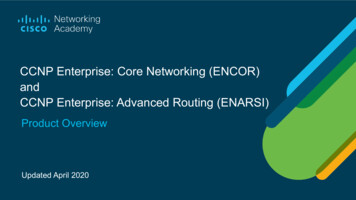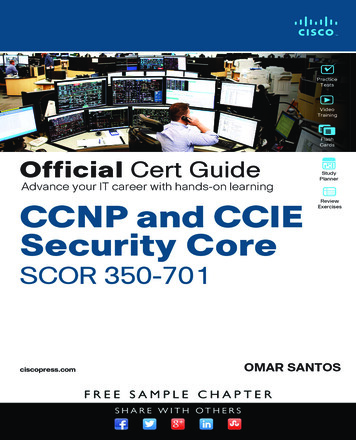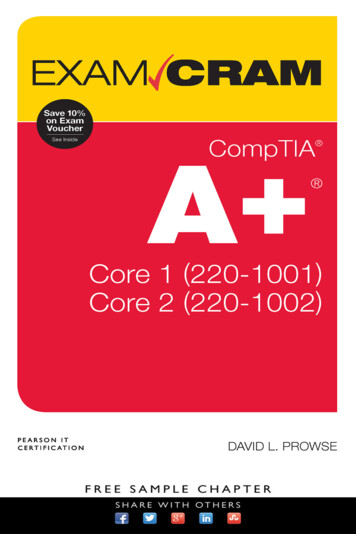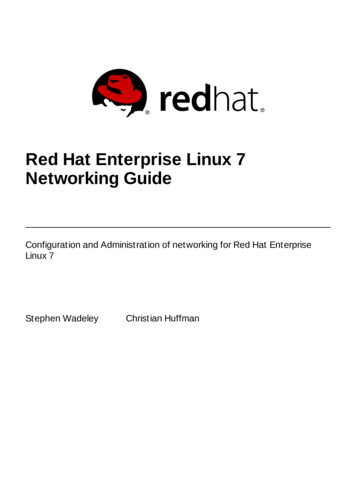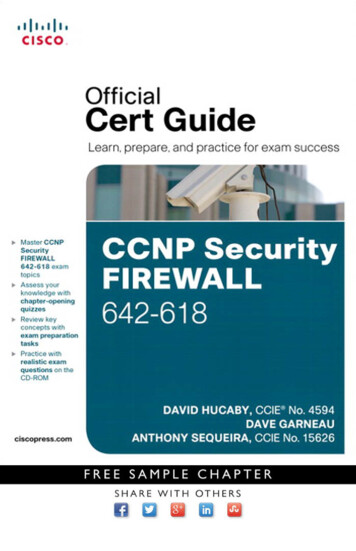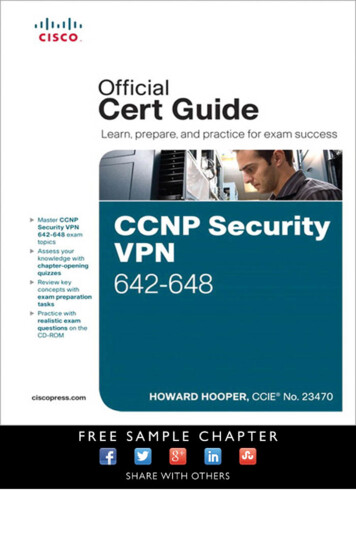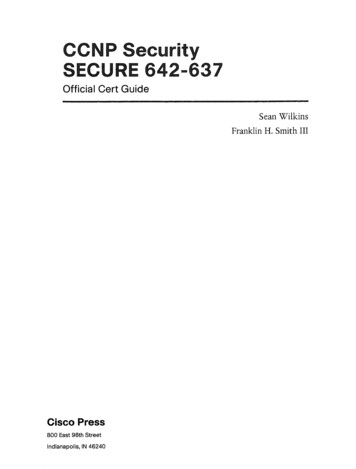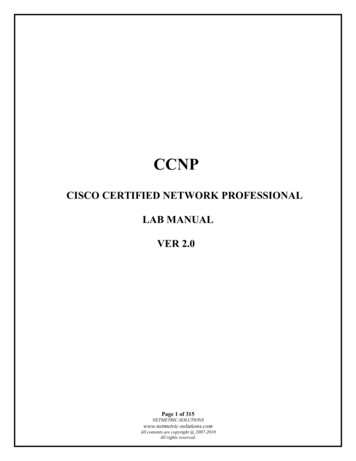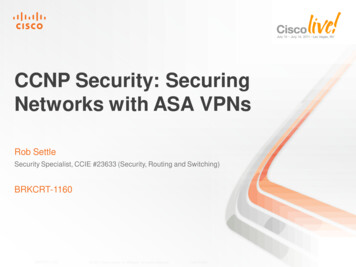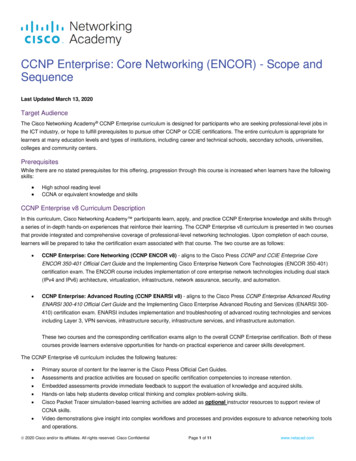
Transcription
CCNP Enterprise: Core Networking (ENCOR) - Scope andSequenceLast Updated March 13, 2020Target AudienceThe Cisco Networking Academy CCNP Enterprise curriculum is designed for participants who are seeking professional-level jobs inthe ICT industry, or hope to fulfill prerequisites to pursue other CCNP or CCIE certifications. The entire curriculum is appropriate forlearners at many education levels and types of institutions, including career and technical schools, secondary schools, universities,colleges and community centers.PrerequisitesWhile there are no stated prerequisites for this offering, progression through this course is increased when learners have the followingskills: High school reading levelCCNA or equivalent knowledge and skillsCCNP Enterprise v8 Curriculum DescriptionIn this curriculum, Cisco Networking Academy participants learn, apply, and practice CCNP Enterprise knowledge and skills througha series of in-depth hands-on experiences that reinforce their learning. The CCNP Enterprise v8 curriculum is presented in two coursesthat provide integrated and comprehensive coverage of professional-level networking technologies. Upon completion of each course,learners will be prepared to take the certification exam associated with that course. The two course are as follows: CCNP Enterprise: Core Networking (CCNP ENCOR v8) - aligns to the Cisco Press CCNP and CCIE Enterprise CoreENCOR 350-401 Official Cert Guide and the Implementing Cisco Enterprise Network Core Technologies (ENCOR 350-401)certification exam. The ENCOR course includes implementation of core enterprise network technologies including dual stack(IPv4 and IPv6) architecture, virtualization, infrastructure, network assurance, security, and automation. CCNP Enterprise: Advanced Routing (CCNP ENARSI v8) - aligns to the Cisco Press CCNP Enterprise Advanced RoutingENARSI 300-410 Official Cert Guide and the Implementing Cisco Enterprise Advanced Routing and Services (ENARSI 300410) certification exam. ENARSI includes implementation and troubleshooting of advanced routing technologies and servicesincluding Layer 3, VPN services, infrastructure security, infrastructure services, and infrastructure automation.These two courses and the corresponding certification exams align to the overall CCNP Enterprise certification. Both of thesecourses provide learners extensive opportunities for hands-on practical experience and career skills development.The CCNP Enterprise v8 curriculum includes the following features: Primary source of content for the learner is the Cisco Press Official Cert Guides. Assessments and practice activities are focused on specific certification competencies to increase retention. Embedded assessments provide immediate feedback to support the evaluation of knowledge and acquired skills. Hands-on labs help students develop critical thinking and complex problem-solving skills. Cisco Packet Tracer simulation-based learning activities are added as optional instructor resources to support review ofCCNA skills. Video demonstrations give insight into complex workflows and processes and provides exposure to advance networking toolsand operations. 2020 Cisco and/or its affiliates. All rights reserved. Cisco ConfidentialPage 1 of 11www.netacad.com
Lab Equipment RequirementsDetailed equipment information, including descriptions and part numbers is available in the CCNP Enterprise Equipment List, which islocated on the Cisco NetAcad Equipment Information site t-information). The labsin the CCNP Enterprise curriculum use the following topology and equipment:CCNP Enterprise Baseline Physical Topology (for both ENCOR and ENARSI)Baseline Equipment Bundle: 3x Cisco 4221 with SEC license (2 with NIM-2T) 2x Cisco Catalyst 3650 Switches (WS-C3650-24TS-E) 1x Cisco Catalyst 2960 Switch (WS-C2960 24TC-L) Ethernet cables as shown in the topology 2x CAB-SS-V35MT (10’ DTE Serial Cable) 2x CAB-SS-V35FC (10’ DCE Serial Cable) PCs - minimum system requirementso CPU: Intel Pentium 4, 2.53 GHz or equivalent o Operating Systems, such as Microsoft Windows, Linux, and Mac OS o RAM: 4 GBo Storage: 500 MB of free disk spaceo Display resolution: 1024 x 768o Language fonts supporting Unicode encoding (if viewing in languages other than English)o Latest video card drivers and operating system updates Internet connection for lab and study PCsSoftware: Cisco IOS versions:o Routers: Version IOS-XE 16.9.4 or higher, universal feature set.o Layer 3 Switches: Version IOS-XE 16.9.4 or higher, ipservices feature set.o Layer 2 Switches: Version IOS 15.2.7 or higher, lanbaseK9 feature setPacket Tracer v7.3 (optional for CCNA skills review activities) 2020 Cisco and/or its affiliates. All rights reserved. Cisco ConfidentialPage 2 of 11www.netacad.com
Open-source server software for various services and protocols, such as HTTP, DHCP, FTP, TFTP, etc.Terminal emulation and SSH client software, such as Tera Term and PuTTy for lab PCs.Oracle VirtualBox, most recent version.Wireshark version: latest stable versionTerminal emulation software for the installed PC operating system 2020 Cisco and/or its affiliates. All rights reserved. Cisco ConfidentialPage 3 of 11www.netacad.com
CCNP Enterprise: Core Networking (ENCOR) OutlineListed below are the current set of chapters and their associated competencies outlined for this course. Each chapter aligns one-to-oneto a chapter in the Cisco Press CCNP and CCIE Enterprise Core ENCOR 350-401 Official Cert Guide. The size of the chapter willdepend on the depth of knowledge and skill needed to master the competencies in the associated chapter.No.Chapter Title1Packet Forwarding234TopicObjectiveCompare hardware and software switchingmechanisms.Network DeviceCommunicationExplain how L2 and L3 devices forwardtraffic.Forwarding ArchitecturesExplain the process of hardware andsoftware Cisco Express Forwarding.Spanning Tree ProtocolConfigure spanning tree protocol in aswitched environment.Spanning Tree Protocol(STP) FundamentalsExplain the purpose of the spanning treeprotocol in a switched LAN environment withredundant inter-switch links.Rapid Spanning TreeProtocol (RSTP)Explain how Rapid PVST operates.Advanced Spanning TreeConfigure STP with protection mechanisms.STP Topology TuningExplain how to modify the root bridge tocontrol the topology.Additional STP ProtectionMechanismsConfigure BPDU Guard and LoopGuard toprotect an STP installation.Multiple Spanning TreeProtocolConfigure multiple versions of the spanningtree protocol.Multiple Spanning TreeProtocol (MST)56VLAN Trunks andEtherChannel BundlesConfigure multiple versions of the spanningtree protocol.Configure multiple versions of the spanningtree protocol.VLAN Trunking Protocol(VTP)Troubleshoot VLAN and trunk configurationsin a switched network.Dynamic Trunking Protocol(DTP)Configure Dynamic Trunking ProtocolEtherChannelsConfigure EtherChannel.Configure routers using different algorithmsto determine the best path.IP Routing EssentialsRouting Protocol OverviewCompare algorithms used by differentrouting protocols to forward packets.Path SelectionExplain how routers determine the bestpath. 2020 Cisco and/or its affiliates. All rights reserved. Cisco ConfidentialPage 4 of 11www.netacad.com
Static Routing78910Configure static, default, and floating staticroutes.Configure EIGRP to improve networkperformance.EIGRPEIGRP FundamentalsDescribe the basic features of EIGRP.Path Metric CalculationDescribe the algorithm used by EIGRP todetermine the best path.Failure Detection andTimersExplain how different types of packets areused to establish and maintain an EIGRPneighbor relationship.SummarizationConfigure EIGRP autosummarization.OSPFImplement multiarea OSPFv2.OSPF FundamentalsExplain the features and characteristics ofthe OSPF routing protocol.OSPF ConfigurationConfigure single-area OSPFv2 in a point-topoint network.Default RouteAdvertisementConfigure OSPF to propagate a defaultroute.Common OSPFOptimizationsConfigure OSPF to improve networkperformance.Advanced OSPFUse advanced OSPF features to optimizenetwork performance.AreasExplain why multiarea OSPF is used.Link-State AnnouncementsExplain how multiarea OSPFv2 uses linkstate advertisements.Discontiguous NetworkExplain how to connect discontiguous areasin OSPFv2.OSPF Path SelectionExplain how OSPF determines the bestpath.Summarization of RoutesConfigure summarization between OSPFareas.Route FilteringExplain how to filter routes in OSPFv2 toimprove performance.OSPFv3Implement single-area OSPFv3.OSPFv3 FundamentalsCompare the characteristics and operationsof OSPFv2 to OSPFv3.OSPFv3 ConfigurationConfigure single-area OSPFv3.IPv4 Support on OSPFv3Explain how IPv4 traffic is supported inOSPFv3. 2020 Cisco and/or its affiliates. All rights reserved. Cisco ConfidentialPage 5 of 11www.netacad.com
11BGPConfigure eBGP in a single-homed remoteaccess network.BGP FundamentalsBasic BGP Configuration121314Describe basic BGP features.Configure an eBGP branch connection.Route SummarizationConfigure summarization in BGP to improveperformance.Multiprotocol BGP for IPv6Configure BGP to support and summarizeIPv6 traffic.Advanced BGPExplain how advanced BGP featuresimprove performance.BGP MultihomingExplain how BGP multihoming to ISPsprovides resilient internet service.Conditional MatchingExplain how ACLs and prefix matchingassist in fine tuning the BGP routingprocess.Route-mapsExplain the purpose of Route-maps in BGP.BGP Route Filtering andManipulationExplain how BGP uses route filtering andmanipulation to improve performance.BGP CommunitiesExplain the function and purpose of BGPcommunities.Understanding BGP PathSelectionExplain what processes are used by BGPfor path selection.MulticastExplain the concepts and protocols that arerequired to understand multicast operation.Multicast FundamentalsDescribe the overall concepts and need formulticasting.Multicast Addressing (L2 &L3)Describe the address scopes used bymulticast to operate at layer 2 and layer 3.Internet GroupManagement ProtocolExplain how IGMP v2 and IGMP v3 allowmulticast groups to start receiving multicasttraffic.Protocol IndependentMulticastExplain the concepts, operation andfeatures of the multicast routing protocolPIM.Rendezvous PointsDescribe the purpose, function, andoperation of a rendezvous point in themulticast network.QoS 2020 Cisco and/or its affiliates. All rights reserved. Cisco ConfidentialExplain the mechanisms used by QoS toensure transmission quality.Page 6 of 11www.netacad.com
151617The Need for QoSExplain how network transmissioncharacteristics impact quality.QoS ModelsDescribe the different QoS models.Classification and MarkingDescribe how QoS classifies and markstraffic based on conditioning policies.Policing and ShapingExplain how policing and shaping algorithmsaffect excess IP traffic.Congestion Managementand AvoidanceExplain how congestion management andavoidance tools are used to avoid networkcongestion.Configure IP services for managed networksthat provide redundancy, addresstranslation and synchronization.IP ServicesTime SynchronizationImplement NTP between an NTP client andNTP server.First Hop RedundancyProtocols (FHRP)Configure HSRP using Cisco IOScommands.Network AddressTranslation (NAT)Configure NAT services on the edge routerto provide IPv4 address scalability.Overlay TunnelsConfigure overlay tunnels to secure site-tosite and remote access connectivity.Generic RoutingEncapsulation (GRE)TunnelsConfigure a site-to-site GRE tunnel.IPsec FundamentalsExplain how the IPsec framework is used tosecure network traffic.Cisco Location/IDSeparation Protocol (LISP)Explain how the routing architecture, LISP,addresses internet routing scalabilityproblems.Virtual Extensible LocalArea Network (VXLAN)Explain how a virtual extensible local areanetworkWireless Signals andModulationExplain the theory of wireless signals andthe methods used to carry data wirelessly.Understanding BasicWireless TheoryDescribe the technology and characteristicsof radio frequency signalsCarrying Data Over an RFSignalExplain methods used to carry data over anRF signal.Maintaining AP-ClientCompatibilityIdentify the standards and methods used tomaintain AP to client compatibility. 2020 Cisco and/or its affiliates. All rights reserved. Cisco ConfidentialPage 7 of 11www.netacad.com
18192021Using Multiple Radios toScale PerformanceExplain how to use multiple radiocomponents to scale performance.Maximizing the AP-ClientThroughputExplain techniques used to maximize AP toclient throughput.Wireless ArchitectureInfrastructureSelect appropriate wireless topologies andantennas to allow APs to pair with WLCs inan enterprise network.Wireless LAN TopologiesCompare how APs operate in autonomousand lightweight mode.Pairing Lightweight APsand WLCsExplain how lightweight APs pair withWLCs.Leveraging Antennas forWireless CoverageSelect appropriate antennas for APs basedon requirements.Understanding WirelessRoaming and LocationServicesExplain how to configure a wireless networkto support and manage wireless roaming.Roaming OverviewExplain how mobile clients roam betweenautonomous APs and intracontrollers.Roaming BetweenCentralized ControllersExplain L2 and L3 roaming strategies.Locating Devices in aWireless NetworkDescribe techniques and business rationalefor locating devices in a wireless network.Authenticating WirelessClientsCompare different methods to authenticatewireless clients before gaining access to thewireless network.Open AuthenticationExplain when wireless clients should accessa network using open authentication.Authenticating with a PreShared KeyExplain how to configure secure wirelessconnections on a WLAN usingauthentication with a pre-shared key.Authenticating with EAPExplain how to configure secure wirelessconnections on a WLAN usingauthentication with EAP.Authenticating withWebAuthExplain how to configure secure wirelessconnections on a WLAN usingauthentication
13.03.2020 · CCNP Enterprise: Core Networking (ENCOR) - Scope and Sequence Last Updated March 13, 2020 Target Audience . 1 Packet Forwarding Compare hardware and software switching mechanisms. Network Device Communication Explain how L2 and L3 devices forward traffic. Forwarding Architectures Explain the process of hardware and software Cisco Express Forwarding. 2 Spanning
